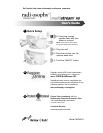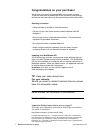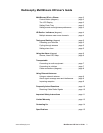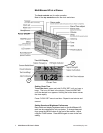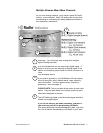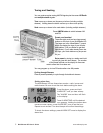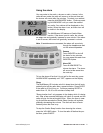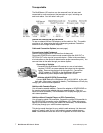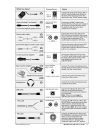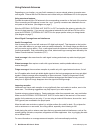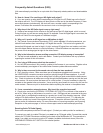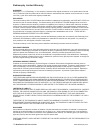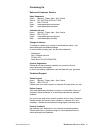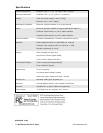9
MultiStream HD User's Guide www.radiosophy.com
Using External Antennas
Depending on your location, you may find it necessary to use an external antenna to receive some
radio signals. External AM and FM antennas are included with your MultiStream HD for this purpose.
Using an external antenna
Connect the external AM or FM antenna to the corresponding connection on the back of the receiver.
When connecting an AM antenna, be sure the + and - (ground) connectors are attached to the cor-
rect posts on the receiver. (See diagram on page 7)
Slide the INTERNAL / EXTERNAL ANT. SWITCH to EXT and position the antenna, extending it to
full size for best reception. If you are not using external antennas for both AM and FM, be sure to
move the INTERNAL / EXTERNAL ANT. SWITCH to the proper position when you change bands.
(See diagram on page 7)
About Signal Coverage Area and Interference
Useful Coverage Area
How far away can you be and still receive an HD digital radio signal? That depends on the local ter-
rain, other radio stations in your area, and man-made interference. All of these things can affect how
well you receive a given station. Plus, a radio signal travels for distances well beyond the area where
it sounds acceptable. Each radio station has a local, distant and fringe coverage area defined by the
Federal Communications Commission (FCC).
Local coverage is the area where the radio signal is strong and almost any radio should get good
reception.
Distant coverage often requires a radio with a good antenna; smaller portable radios may not
receive the signal.
Fringe coverage is the area where reception is possible only with a good external antenna, if at all.
An HD capable radio should get reliable digital signals in the local coverage area and may get digital
signals in distant coverage areas, depending on the environment. Radios in fringe areas usually
don't receive digital signals because, unlike a traditional analog signal that fades out as you travel
away from it, digital will simply disappear when the signal isn't strong enough.
Improving reception
Interference can cause radio reception to vary significantly from one location to another, even in the
same room. The following suggestions may help improve your radio reception:
Consider using an external antenna. Passive antennas, rather than powered ones, may work better.
Make sure the INTERNAL / EXTERNAL ANT. SWITCH on the back of the receiver is in the correct
position for the antenna you are using. If you are using an external AM antenna, be sure the + and -
GND (ground) are connected to the proper posts.
Move the radio near a window or place it on a higher surface like a shelf or desk. Do not place the
radio or antenna on or near metal, like a filing cabinet, especially when listening to AM.
Avoid placing the radio or antenna near items that may generate electrical interference, such as fluo-
rescent lighting, fish tanks, computers, refrigerators and other appliances. Also, try plugging the radio
into a different outlet.
For more information on coverage areas and reception, visit www.radiosophy.com/help.



